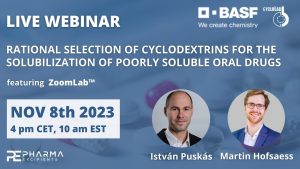Excipient Impact on Fenofibrate Equilibrium Solubility in Fasted and Fed Simulated Intestinal Fluids Assessed Using a Design of Experiment Protocol

Solubility is a critical parameter controlling drug absorption after oral administration. For poorly soluble drugs, solubility is influenced by the complex composition of intestinal media and the influence of dosage form excipients, which can cause bioavailability and bioequivalence issues. This study has applied a small scale design of experiment (DoE) equilibrium solubility approach in order to investigate the impact of excipients on fenofibrate solubility in simulated fasted and fed intestinal media. Seven media parameters (bile salt (BS),phospholipid (PL), fatty acid, monoglyceride, cholesterol, pH and BS/PL ratio) were assessed in the DoE and in excipient-free media, and only pH and sodium oleate in the fasted state had a significant impact on fenofibrate solubility. The impact of excipients were studied at two concentrations, and for polyvinylpyrrolidone (PVP, K12 and K29/32) and hydroxypropylmethylcellulose (HPMC, E3 and E50), two grades were studied.
Mannitol had no solubility impact in any of the DoE media. PVP significantly increased solubility in a media-, grade- and concentration-dependent manner, with the biggest change in fasted media. HPMC and chitosan significantly reduced solubility in both fasted and fed states in a media-, grade- and concentration-dependent manner. The results indicate that the impact of excipients on fenofibrate solubility is a complex interplay of media composition in combination with their physicochemical properties and concentration. The results indicate that in vitro solubility studies combining the drug of interest, proposed excipients along with suitable simulated intestinal media recipes will provide interesting information with the potential to guide formulation development.
Download the full article as PDF here Excipient Impact on Fenofibrate Equilibrium Solubility in Fasted and Fed Simulated Intestinal Fluids Assessed Using a Design of Experiment Protocol
or read it here
Materials
Sodium taurocholate (>97%), monosodium dihydrogen phosphate (100%), ammonium formate (>99.995%), formic acid (98–100%), sodium chloride (NaCl), potassium hydroxide (KOH, >85%), hydrochloric acid solution (HCl, analytical grade), acetic acid (>99.7%), cholesterol (>99%), chloroform (99.5%), fenofibrate, and chitosan (from crab shells, practical grade) were purchased from Sigma-Aldrich, Poole, Dorset, UK. Lecithin S PC (phosphatidylcholine from soybean, 98%) was supplied by Lipoid, Ludwigshafen, Germany. Sodium oleate (technical grade) was obtained from BDH Chemicals Ltd., Poole, England. Monoglyceride (glyceryl mono-oleate, >92% monoester, and 88% oleic acid) was supplied by CRODA. Polyvinylpyrrolidone (PVP, Plasdone TM K-12 and Plasdone TM K-29/32) were from Ashland, Singapore. Hydroxypropyl methylcellulose (HPMC, Hypromellose) (Methocel E3 and E50 premium LV) were obtained from Colorcon Ltd., Kent, UK. Mannitol (pharmaceutical grade) was obtained from Blackburn Distributions, Nelson, UK. All water used was ultrapure Milli-Q. Methanol and acetonitrile was purchased from VWR Prolabo Chemicals, Poole, UK.
Ainousah, B.E.; Khadra, I.; Halbert, G.W. Excipient Impact on Fenofibrate Equilibrium Solubility in Fasted and Fed Simulated Intestinal Fluids Assessed Using a Design of Experiment Protocol. Pharmaceutics 2023, 15, 2484. https://doi.org/10.3390/pharmaceutics15102484
See the webinar:
“Rational Selection of Cyclodextrins for the Solubilization of Poorly Soluble Oral Drugs”, 8. November 2023:
Get more information & register here for free:


